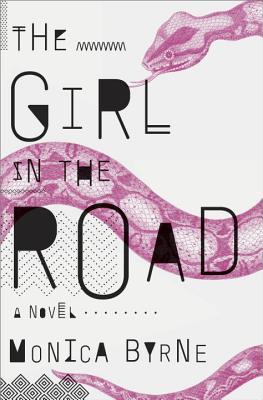 Not many books “get” mental illness. I wrote several months ago about how Hyperbole and a Half handled depression, and I stand by my assertion that it is one of the best depictions of mental illness I’ve ever seen. That being said, Monica Byrne’s The Girl in the Road is runner-up, beaten by Allie Brosh’s graphic novel memoir by only a hair.
Not many books “get” mental illness. I wrote several months ago about how Hyperbole and a Half handled depression, and I stand by my assertion that it is one of the best depictions of mental illness I’ve ever seen. That being said, Monica Byrne’s The Girl in the Road is runner-up, beaten by Allie Brosh’s graphic novel memoir by only a hair.
The Girl in the Road makes no secret of the fact that one of its protagonists, Meena, has a mental illness. She tells us herself that she’s manic, but we’re the ones who discover she’s paranoid, as well. Everyone is following her, part of a plot to kill her after an assassin’s venomous snake failed to do so. When she hits the Trail — a wave energy-generating bridge connecting India and Djibouti — in a quest to learn more about her murdered parents, her mental health rapidly deteriorates.
Mariama’s story is juxtaposed with Meena’s, but just how the two protagonists’ narratives are connected remains a mystery until the novel is nearly at its close. Mariama is a young runaway with a dark, undisclosed past. She’s sexually precocious and latches onto the adults who come into her life — often innocently, on their part — in unnerving ways. As she ages throughout The Girl in the Road, we come to realize that Mariama is just as ill as Meena, if not moreso.
If it isn’t clear already, The Girl in the Road is, at times, disturbing. I don’t often put books down, but there were more than a few times I contemplated closing Byrne’s novel and writing that I could not finish it. I’m glad I didn’t, but let’s say that many of the book’s darker details — which include graphic depictions of murder and rape — aren’t easily scoured from the mind.
That isn’t the novel’s only downside, either. The Girl in the Road drags in the middle: after Meena has begun her journey along the Trail and before Mariama’s story has taken its more dramatic turns. The back third of the book is a line of tipped dominoes, however, with each exciting development falling and catalyzing the next.
The Girl in the Road may also prove difficult for Western readers, given its settings: Ethiopia, Djibouti, and India. Byrne doesn’t often offer explanations for places and things she mentions, and the arrangement of vowels and consonants in the non-English words may make the reading feel like slogging through a foreign language dictionary. I support the author’s decision not to translate her work, but I think Westerners unaccustomed to reading about non-Western civilizations deserve a heads-up before they attempt her novel.
After finishing The Girl in the Road, I feel as if it didn’t tell me everything, even though I know it did, mostly. In reality, there’s only one question left unanswered by the end, and it seems ridiculously unimportant after the conclusion. But Byrne’s novel repeats its symbols — the goddess, the snake, the sun, the girl in the road — so often that feeling as if you’re missing something becomes commonplace. I’ve heard this before, you think, and you begin to wonder just how reliable the narrators are. And then you think, Maybe that’s the point.
My rating: 4 out of 5 stars
I received this book from the Blogging for Books program in exchange for this review.
Image credit: Stephanie Watson/Flickr
